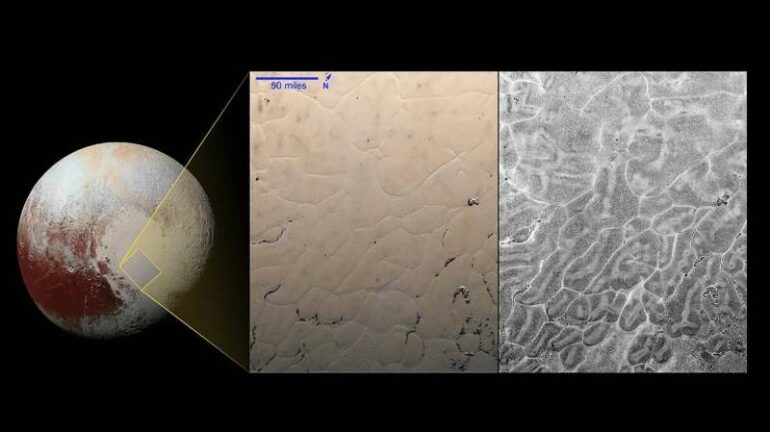The world first glimpsed Pluto up close when NASA’s New Horizons spacecraft whizzed by it in July 2015. One of the most exciting discoveries scientists made based on New Horizons data was that Pluto, despite orbiting at more than 5 billion kilometers from the sun, may contain a liquid water ocean under its water ice surface.
This liquid water ocean has huge implications for how Pluto formed and retained enough heat to melt all that ice. In the years since the New Horizons flyby, two general formation hypotheses have emerged. The first starts with a “cold” Pluto, which involves Pluto forming over millions of years by the slow accretion of cold objects. This version of Pluto eventually would have coalesced enough material that radiative heating from the inside would melt the subsurface ocean. The other hypothesis involves a “warm” or “hot” Pluto, in which Pluto formed over a shorter time period in violent collisions that heated its interior, formed the ocean, and eventually cooled the planet into the majority ice ball we know today.
One clue that can help scientists understand Pluto’s formation is the thickness of its outer icy crust as well as the geological features that make up its surface. In a new study, McGovern et al. focused on Sputnik Planitia, a vast basin that makes up the western portion of Pluto’s bright “heart.” Sputnik Planitia formed after an impact and eventually filled in with nitrogen ice. Heat driven by convection formed cell-shaped structures in the nitrogen ice, which has captivated scientists. This basin measures 1,500 × 900 kilometers and features a ridge that rises 1 kilometer above the surrounding landscape. Fractures and cracks radiate from the basin like spokes on a bicycle wheel, the authors write.
These fractures and cracks are key to understanding how the nitrogen ice load affects Pluto’s surface, which would depend on how thick that surface is. The nitrogen ice pushes down on Pluto’s outer layer, or lithosphere. Depending on the thickness of the lithosphere when the nitrogen ice first flowed into the basin, different patterns of cracks would form.
The researchers ran computer models testing various starting conditions for Sputnik Planitia to find the lithosphere thickness that best fits today’s geological features. They found that the lithosphere is probably 45–70 kilometers thick and that the initial depth of the impact crater that forms Sputnik Planitia was probably shallow, no more than 3 kilometers deep.
McGovern and colleagues note that their finding is consistent with the “hot” theory of Pluto formation that posits Pluto formed via violent impacts and started out with more liquid, much of which froze over the following millennia. They also note that the stress on the outer shell created by the nitrogen ice is probably facilitating some cryovolcanism at several sites surrounding Sputnik Planitia.
More information:
P. J. McGovern et al, Tectonism and Enhanced Cryovolcanic Potential Around a Loaded Sputnik Planitia Basin, Pluto, Journal of Geophysical Research: Planets (2021). DOI: 10.1029/2021JE006964
Provided by
American Geophysical Union
This story is republished courtesy of Eos, hosted by the American Geophysical Union. Read the original story here.
Citation:
Clues to Pluto’s history lie in its faults (2022, February 1)



